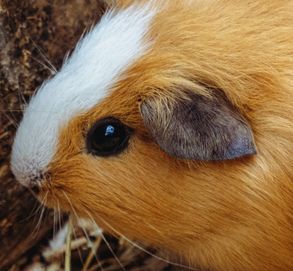
Guinea pigs make wonderful pets and can communicate with each other and their human family using a variety of sounds. These highly social animals normally do best kept in pairs or larger groups unless they spend a lot of time out with their owners.
DIET
Hay - timothy, orchard, Bermuda, and/or other types of hay. This should be available at all times to keep its teeth worn properly and to keep its stomach and intestine healthy.
Pellets – Adults should be fed ¼ cup of timothy-based pellets daily; excessive pellets can lead to problems with dental disease, bloating, constipation, and diarrhea. Seed-based mixes should be avoided. Young, growing guinea pigs and pregnant or nursing sows can be offered a little bit of alfalfa hay every day to provide a little extra protein to support growth. Offer pellets that are also a little richer in protein and other nutrients, such as Oxbow's Young Guinea Pig Food. These pellets should be available all the time until weaning, then limited to 1/4 cup daily.
Greens – Feed a heaping cup of leafy greens daily such as leaf lettuce, collard greens, and mustard greens. Avoid sugary or starchy vegetables.
Vitamin C - Oxbow Natural Science Vitamin C treats are a good way to provide these vitamins, although chewable vitamin C products for people may also be used. If you use a human product, make sure you break it into smaller pieces so you are not giving more than 10 mg to your guinea pig per day. We do not recommend adding vitamin C to the water as it makes the water taste bad and many guinea pigs will go thirsty rather than drinking the vitamin-enriched water. Additionally, the vitamin C deteriorates quickly in the water bottle.
WATER
Fresh water should always be available and can be offered in either water bowls or water bottles depending on the guinea pig’s preference. Water should be changed daily. Disinfect the bowl or bottle with a solution of 1 tablespoon bleach to 1 cup of water at least once a week and rinse thoroughly with fresh water before refilling it for your guinea pig.
CAGING
Enclosure: Two adults need a cage that is minimally 4 feet long, 3 feet wide, and 2 feet tall. A solid floor is recommended since wire floors may result in sores developing on their feet.
Accessories: Provide at least two plastic guinea pig hutches or cardboard boxes big enough to hide in (but not so cramped a guinea pig can't turn around). It is a good idea to have at least two hide boxes per guinea pig. The cage should be well-ventilated.
Bedding: Recycled paper products, such as Yesterday’s News™ or Carefresh™, work well as substrates, as do paper towels and blank newsprint (available from specialty paper shops or online paper supply companies). Some owners also have good luck with using fleece blankets changed and laundered daily.
Litter Boxes: Guinea pigs can quickly learn to use litter boxes. Place a couple of old fecal pellets in with the litter to get them started. Paper pulp products, such as Yesterday’s News™ or Carefresh™, or compressed straw pellets, such as Eco-Straw Litter, should be used in the litter box. Clean the litterbox daily or more often if needed.
TEMPERATURE
Guinea pigs can become overheated or cold easily. Do not expose your guinea pig to temperatures above 85°F for prolonged periods.
HANDLING
Always scoop up a guinea pig to fully support all four feet and its belly. Children under the age of ten should always have older experienced guinea pig handlers help them hold their pet.
Copyright © All Rights Reserved
